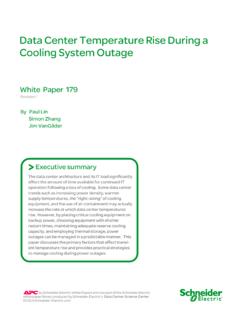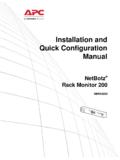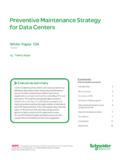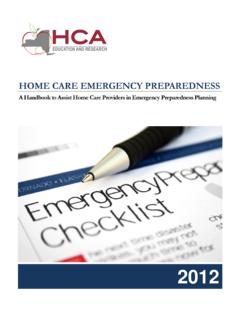Transcription of How to Prepare and Respond to Data Center Emergencies
1 How to Prepare and Respond to data Center Emergencies Revision 0 White Paper 217 by Leonid Shishlov Mark Rentzke Zhang Yong Ping Patrick Donovan Executive summary data Center operations and maintenance teams should always be prepared to act swiftly and surely without warning. Unforeseen problems, failures, and dangers can lead to injury or downtime. Good preparation and process, however, can quickly and safely mitigate the impact of Emergencies , and help prevent them from happening again. This paper describes a framework for an effective emergency preparedness and response strategy for mission critical facilities. This strategy is com-posed of 7 elements arranged across 3 categories: Emergency Response Procedures, Emergency Drills, and Incident Management.
2 The paper de-scribes each element and offers practical advice to assist in implementing this strategy. Schneider Electric data Center Science Center White Paper 217 Rev 0 2 How to Prepare and Respond to data Center Emergencies As stated in White Paper 196, Essential Elements of data Center Facility Opera-tions, even an expertly engineered and thoroughly commissioned Tier IV-certified data Center cannot guarantee 100% availability. Business interruptions due to the unplanned downtime of IT systems will always remain a risk. Good preparation is the best defense, and will help ensure responses are timely, effective, and error-free.
3 Preparedness begins with developing emergency operating procedures (EOPs) for all identified high-risk failure scenarios, such as the loss of a chiller plant, failure of the generator to start, and so on. Escalation procedures also need to be developed and rehearsed to ensure the chain of command is informed and the appropriate resources are brought to bear as the situation develops. Scenario drills should be regularly conducted to rehearse and evaluate both team and individual emergency response effectiveness. Once an incident has been dealt with and its effects mitigated, an analysis should be conducted to understand what the root causes were and how effective the emergency response was in dealing with the problem.
4 Formal failure analysis for significant facility events is a fundamental part of the overall continuous improvement process that is needed to reduce failures and improve response effectiveness in future events. Table 1 gives a short overview of key aspects of an effective emergency prepared-ness and response program for data centers. There are seven key elements, which are grouped within three higher-level categories. Category Element Short description Emergency response procedures Emergency operating procedures (EOPs) EOPs provide a plan of action for safely isolating faults and restoring service or redundancy Crisis management plan (CMP)
5 A detailed step by step plan of action on what to do in the event of a crisis situation Escalation procedures Escalation procedures are documented, prioritized contact lists that outline internal contact requirements for specific situations related to data Center operations Emergency drills Emergency drills Emergency drills scheduled and per-formed in line with top 10 identified operational risks, help ensure readiness Incident management Incident notification A process that ensures any safety or mission critical event is made known to appropriate personnel Incident identification and reporting All incidents must be reported immediately once the situation is stabilized.
6 A brief summary of the incident should be sent to the appropriate distribution list as defined by the incident s level of severity Failure analysis A comprehensive program to determine a root cause is required for any incident that involves an injury or system downtime, or has the likelihood of doing so EOPs are discussed first since quickly and safely isolating a fault, restoring service, and rendering first aid is obviously the most critical and urgent aspect of emergency response procedures. Next, a crisis management plan (CMP) is described as the Introduction Table 1 Overview of key ele-ments of an emergency preparedness and response strategy for data centers Even an expertly engineered and thoroughly commissioned Tier IV-certified data Center cannot guarantee 100% availability.
7 Schneider Electric data Center Science Center White Paper 217 Rev 0 3 How to Prepare and Respond to data Center Emergencies overall plan for dealing with urgency and crisis in a data Center that, if left un-checked, will lead to a disaster. (See sidebar for an explanation of the terms crisis and disaster .) Finally, the role of emergency drills and incident management is explained as important aspects of a program to be continuously prepared for problems and to be better able to detect issues before they become a crisis or worse yet, a disaster. Emergency operating procedures (EOPs) are used for handling crisis and disasters as soon as they are detected.
8 EOPs should exist as documents and preferably maintained through a computerized document management system (CDMS). Each procedure describes an approved set of actions for how to Respond to a crisis or disaster. The response should cover how to safely isolate the fault and how to restore service or redundancy. The EOP aims to have facility operators Respond in the correct sequence of events for the purpose of safety and minimizing the duration and impact of the emergency. An EOP has multiple functions. First, it assists operators in placing the affected system(s) into a controlled and stabilized condition as quickly as possible. Second, it provides step-by-step guidance to ensure all activities are carried out in a safe and deliberate manner.
9 This is done to prevent further (or wider) service interruption, equipment damage, or personal injury. These negative or possibly even devastating effects result from performing work in an uncontrolled manner, by omitting essential steps, or by performing them incorrectly, or half-heartedly. A third function of EOPs is as a training tool for new operators. They should be used as the basis for scenar-io drills and testing in staff training programs (as discussed later in the paper). They are also important to have when audited or evaluated by customers or management to demonstrate effective emergency preparedness and response. It is a common mistake to equate EOPs as being the same thing as standard operating procedures (SOPs).
10 SOPs provide generic guidance or instructions on performing more mundane, day-to-day normal operation type tasks, such as putting a UPS into bypass or other maintenance tasks. An SOP is concerned with how to operate or maintain a system. It does not describe how to deal with and recover from a failure or emergency situation. If operators only rely on SOPs to give them an understanding of how the equipment works and is maintained, the result is a reduced state of readiness for real Emergencies . Critical failures often have causes and effects that span across multiple systems. SOPs, on the other hand, generally only address specific pieces of gear.

















